|
1.
CENTRAL AND WEST AFRICA
Regional up-date
Cameroon
Mills that were required to cease operations because of
non-compliance under CFAD regulations have mostly
returned to full production under rigorous forestry
oversight.
Some say the lower labour costs, port efficiency and the
plentiful log sources gives operators in Cameroon an
advantage over its neighbours. While general labour is
available, there remains a shortage of skilled technicians
which continues to challenge sawmill and logging
operations, prompting calls for expanded vocational
training and reconsideration of the limit on foreign
workers.
Rail services on the Douala–Ngaoundéré line remain
reliable, say operators, with no major disruptions reported.
Operators continue to use both rail and road transport to
reach Douala and Kribi Ports. Douala Port has seen a
slight uptick in organisational efficiency but it is reported
vessels face a five to seven day wait to berth.
It has been observed that container vessels enjoy priority
which sometimes extends delays for timber carriers. Kribi
Port continues to handle mostly containerised exports,
including increasing sawnwood volumes from northern
Congo.
Producers in Cameroon say order levels are steady across
traditional markets though volumes remain modest.
China’s demand is very weak, while enquiries from the
Middle East have improved with renewed interest in iroko,
sapelli and other redwoods. Producers are optimistic that
Cameroon’s adherence to legal requirements, combined
with lower costs compared with Gabon and Congo,
improve competitiveness.
Gabon
The new government has taken office. The most
significant government shuffle saw Henri-Claude Oyima,
Chairman and CEO of the Gabonese International Bank
BGFI, appointed as Minister of Finance and Economy.
The domestic media says Oyima wants to remain at the
helm of BGFI. General Maurice Ntossui Allogo retains the
forests and water portfolio. Ambitious proposals to tap
carbon-credit revenues are circulating as the government
faces difficulty in financing its extensive infrastructure
projects.
As the rainy season persists the timber sector and the
country at large awaits a two-month dry window
beginning in June to ease transport and harvesting
operations. In the GSEZ log park at Bigein it is said
around 20,000 cu.m of okoumé peeler logs are currently
stocked ready for delivery to mills.
It is understood SETRAG, the national railway operator,
has requested financial support from the African
Development Bank to restore tracks and bridges on the
Libreville–Franceville line.
Power outages have eased slightly. Residents say there is
now typically one scheduled blackout on weekdays
compared to the previous twice‐daily schedule. The
floating power barges have improved overall grid
reliability but businesses remain on guard for unscheduled
interruptions.
Owendo Port is operating under normal conditions, though
a two-to-three-day berth backlog remains typical in part
because of the length of some vessels which occupy a
quay space that could otherwise handle two shorter ships.
Unskilled labour shortages continue and mill owners have
petitioned the government for additional expatriate worker
permits. Gabonese technicians are scarce despite the
presence of a technical school in the GSEZ. Observers say
local workers overwhelmingly prefer civil‐service roles to
forestry or mill work.
Republic of the Congo
Producers say operations are muted because of sluggish
global demand. Veneer mills are said to be negotiating
with European buyers despite stiff competition from
Gabonese products.
Okoume sawn timber continues to ship out to the
Philippines while sapelli, sipo and other redwoods serve
traditional markets in Europe and the Middle East. The
southern forests will soon enter a two-month dry spell
though the north may already be encountering the onset of
its wet season.
No new forestry regulations have been introduced.
Enforcement of CITES continues to tighten with exporters
reporting lengthened documentation time-lines.
Producers express cautious optimism that flexible log
export quota management and stable port operations will
support gradual recovery. However, global market
headwinds, particularly in China and Europe, continue to
dampen growth prospects.

2.
GHANA
New Forestry Commission Board inaugurated
The Minister for Lands and Natural Resources, Emmanuel
Armah Kofi Buah, has officially sworn-in the new board
for the Forestry Commission of Ghana.
According to the Minister the inauguration marks a
significant milestone in the sustainable management of
Ghana’s forest and wildlife resources ensuring that both
current and future generations continue to benefit from
them.
At the official swearing-in ceremony the Minister tasked
them with the responsibility to lead, direct and oversee the
activities of the Commission. He emphasised the major
threats facing the nation’s forests include illegal mining
(galamsey), illegal logging, wildfires and other harmful
activities.
“These challenges not only degrade our ecosystems but
also threaten the livelihoods of communities that depend
on these natural resources,” he stated.
The Board Chair, Prof. Martin Oteng-Ababio, pledged the
team’s commitment to support the Chief Executive and
management in addressing key internal and external
challenges and to reposition the Forestry Commission as a
robust and efficient agency.
He affirmed his commitment to lead with integrity and
build institutional resilience, ensuring that Ghana’s forest
and wildlife resources serve both present and future
generations.
The members of the new Board included Dr. Hugh A.
Brown, Chief Executive of the FC, Kumbun Na Yiri II
(National House of Chiefs), Richard Duah Nsenkyire
(Timber Trade and Industry), Tetteh-Hevy Oman (Wildlife
Trade and Industry), Dr. Abukari Nantgmah Attah (Ghana
Institute of Professional Foresters), Dominic Kwasi
Nyanzu (Non-governmental organisation in Forest and
Wildlife Management), Surveyor Raphael Hokey Esq.
(Lands Commission). The others are Brig Gen (Rtd) Dr.
Albert Kabenlah Adu, Nana Kojo Toku and Mavis
Kuukua Bissue, MP, persons with financial, commercial
and managerial experience nominated by the Minister.
See: https://fcghana.org/fc-board-inaugurated/
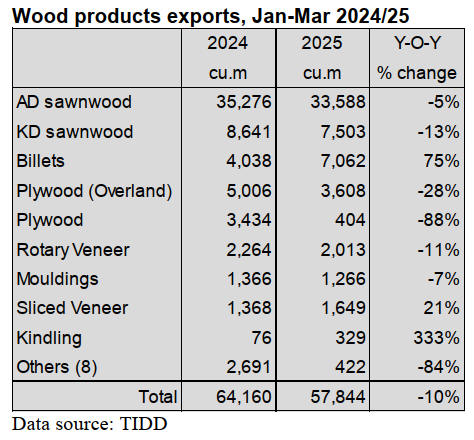
Timber exports dip but business still good in Asian
markets
The volume of wood products exported from Ghana in the
first quarter of 2025 totaled 57,844 cu.m, 10% lower than
in the corresponding quarter in 2024. The receipts totalled
Euro27.50 million which was a decrease of 6% over that
in the first quarter of the previous year.
For the 3-months period, products that recorded significant
increases in volumes year-on-year were kindling (+333%),
billets (+75%) and sliced veneer (+21%).
Air-dried sawnwood was the leading product shipped
during the first quarter. The product accounted for 58%
and 50% of the total export volume and value respectively
for the period in 2025. While for the same period in 2024,
the product accounted for 55% in volume (35,276 cu.m)
and 50% in value.
The data showed that, business in the Asian markets was
still good as total wood products accounted for 68.9% of
the total export volume in 2025 as against 62.4% achieved
for the same period in 2024.
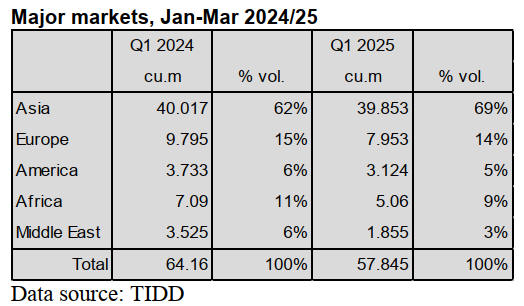
Exports to Asian markets for the period January-March
2025 earned the country Eur 15.91 million (58% of the
total) from a volume of 39,853 cu.m, representing a
modest increase in value but a decline in volume.
Compared to the same period in 2024 the total revenue
was Eur15.73 million from 40,017 cu.m.
Air-dried sawnwood, billets and sliced veneer produced
from teak, denya, wawa, ceiba, cedrela, gmelina, odum,
koto/kyere, dahoma and Chenchen were some of the main
products exported.
Strategy to export competitiveness
The President, John Dramani Mahama, has disclosed that
his administration, through the Accelerated Export
Development Programme (AEDP), is implementing an
ambitious strategy to significantly boost Ghana’s export
competitiveness under the African Continental Free Trade
Area (AfCFTA).
In a national address to mark his first 120 days in office
the President stated that the AEDP aims to triple the
number of Ghanaian firms certified under AfCFTA’s
Rules of Origin, scale up export readiness training
particularly for youth and women and expand the
country’s reach into new continental markets while
deepening existing trade partnerships.
The President assured the nation of his commitment to
deliver tangible results to drive the nation from gloom to
bloom, make corruption unattractive and punish those that
steal from the public purse.
According to IMANI Africa’s independent assessment of
the Mahama administration’s 120-Day Social Contract
with Ghanaians, has shown early energy with good
progress. But IMANI flags critical gaps in fiscal
discipline, policy design and long-term economic impact.
(IMANI, Center for Policy & Education a Think Tank based in
Ghana)
Some flagship initiatives, such as Adwumawura (a
flagship initiative by the Government of Ghana to create at
least 10,000 sustainable youth-led businesses annually)
and the 24-Hour Economy are active but risk becoming
costly without clear returns.
The assessment recommended an urgent focus on linking
flagship programmes to economic productivity, reforming
SOEs and strengthening procurement, modernising
revenue systems and embedding institutional
accountability into delivery.
See: https://www.graphic.com.gh/news/general-news/ghana-
news-mahama-fulfils-72-120-day-pledge.html
and
https://mcusercontent.com/ecdb99e358564505c615d47c1/files/7
b77decd-aee2-0fc8-fb18-
87b4dbd22908/Assessment_of_President_Mahama_rsquo_s_120
_Day_Social_Contract.pdf
Local currency gains strength
The local currency has seen some stability against major
international currencies as it has been steady at around
GHS15.50 to the US dollar. But in the first week of May
2025 it surged to GHS13.10 to record its strongest level in
a year.
The currency stability has been attributed to several
factors which include US$2.3 billion in gold exports, an
increase in cocoa export receipts totalling US$835 million
in 2025 against US$639 million in 2024 and the
weakening of the US dollar.
On the domestic side, the government has taken steps to
restore investor confidence as it has resisted high-interest
rate bids in the treasury bill market, signalling a tougher
stance on debt accumulation.
Meanwhil, the Ghana Union of Traders’ Associations
(GUTA) has called on traders in the Small Medium
Enterprise category to cut prices in response to the recent
appreciation of the cedi. GUTA appealed to the trading
community to reflect the currency gains in their pricing.
According to GUTA the cedi has made “significant gains”
against major trading currencies and wants traders to act
quickly to translate this into some relief for ordinary
Ghanaians.
See: https://www.myjoyonline.com/explainer-why-the-cedi-is-
gaining-ground/
and
https://www.myjoyonline.com/adjust-prices-with-immediate-
effect-guta-to-traders-as-cedi-gains-strength/

3. MALAYSIA
Ministry sole issuer of Certificates of Origin
The Ministry of Investment, Trade and Industry (Miti)
will, with immediate effect, be the sole issuer of
Certificates of Origin (CoO) for exports to the US. This
move comes as Malaysia works to prevent illicit trans-
shipment through Malaysia. Issuance of such certificates
by business councils, chambers or associations appointed
by Miti has ceased. The move tightens the control over the
documents that prove the origin of goods for customs or
trade requirements.
The decision follows reports that certain exporters may
have used Malaysia as a trans-shipment hub to bypass US
tariffs on third-country goods. The extent of Malaysia’s
involvement in trans-shipment activities is still being
quantified but Miti is taking back the power to issue CoOs.
Miti said it will also enhance audits on applicants of
certificates of origin, investigate and take the necessary
action in collaboration with the Royal Malaysian Customs
Department to curb any offences.
Exporters are said to be unsure if the criteria for getting a
certificate of origin have changed after the Ministry of
Investment, Trade and Industry (Miti) took over as the
sole issuer replacing chambers of commerce.
See:
https://ceomorningbrief.theedgemalaysia.com/article/2025/0952/
Home/2/753968
and
https://theedgemalaysia.com/node/754504
FSC to maintain association with Samling
In October 2022 a coalition of organisations including
SAVE Rivers, GCRAC (Gerenai Community Rights
Action Committee), KERUAN Organisation, The Borneo
Project and Bruno Manser Fund submitted a complaint to
the Forest Stewardship Council’s (FSC) against Samling
Global Limited. The allegations made by the complainants
alleged unacceptable activities according to FSC´s Policy
for Association.
In a press release of 25 April FSC announced that, based
on the recommendation of a panel of independent experts
who assessed available evidence related to the Policy for
Association case against Samling and reported findings to
the FSC International’s Board of Directors. It was decided
to maintain association with Samling Global Limited
provided they fulfil conditions to verify and address
potential environmental and social harms caused in their
forest operations.
The Forest Department in Sarawak welcomed the Forest
Stewardship Council’s (FSC) recent decision.
See: https://fsc.org/en/newscentre/integrity-and-disputes/fsc-
decides-to-maintain-conditional-association-with-samling
and
https://www.theborneopost.com/2025/05/10/sarawak-forest-dept-
welcomes-fscs-conditional-continuation-with-samling-group/
Major player exits timber business
WTK Holdings Bhd, one of the ‘big six’ groups of timber
companies in Sarawak, is exiting the timber business and
according to the domestic press will shift its focus to more
commercially sustainable and profitable business
segments. The local media has reported the group aims to
prioritise its plantation and food operations.
See: https://www.thestar.com.my/business/business-
news/2025/04/30/wtk-disposes-of-timber-subsidiary-for-
rm235mil
Tallest tropical tree
Sabah forest is home to the world’s tallest tropical tree
species, locally known as ‘Seraya Kuning Siput’.
Known as ‘Menara’ in Malay (meaning tower), it stands at
a record-breaking height of 100.8 m (328 feet), making it
not only the tallest tropical tree but the third tallest tree in
the world, after the Coast Redwood (Hyperion) in
California, measuring 116 m and the Tibetan Cypress
(102.3 m) in China.
See: https://www.theborneopost.com/2025/05/04/worlds-tallest-
tropical-tree-species-iconic-natural-wonder-of-sabah/
4.
INDONESIA
Export Benchmark Price (HPE) May 2025
The following is a list of Wood HPE from 1to 31 May
2025.

Processed wood (prices per cu.m)
Processed wood products which are leveled on all four
sides so that the surface becomes even and smooth with
the provisions of a cross-sectional area of 1,000 sq.mm to
4,000 sq.mm (ex 4407.11.00 to ex 4407.99.90)
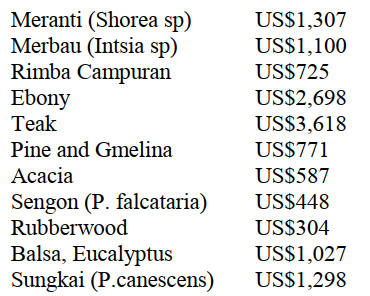
Processed wood products which are leveled on all
four
sides so that the surface becomes even and smooth of
Merbau wood with the provisions of a cross-sectional area
of 4000 sq. mm to 10,000 sq.mm (ex 4407.11.00 to ex
4407.99.90) = US$1,500/cu.m
See: https://jdih.kemendag.go.id/peraturan/keputusan-menteri-
perdagangan-republik-indonesia-nomor-592-tahun-2025-tentang-
harga-patokan-ekspor-dan-harga-referensi-atas-produk-
pertanian-dan-kehutanan-yang-dikenakan-bea-keluar
Furniture manufacturers request review of new
quarantine rules
The Indonesian Furniture and Craft Industry Association
(Himki) has called on the government to delay the
implementation of a new policy from the Indonesian
Quarantine Agency as it could negatively affect the export
of furniture and craft industry products.
Himki Chairman, Abdul Sobur, expressed concern that the
new regulation introduces complicated procedures and risk
export delays. He believes these issues could undermine
the competitiveness of Indonesian products in the global
market.
Sobur stated "ironically, this regulation contradicts the
national initiative to boost creative industry exports. We
question the rationale behind this regulation as it does not
consider the unique characteristics of the furniture and
craft industry”.
He added "we believe that implementing this regulation
without a specific mechanism for finished goods is an
unfair policy. It equates creative industry products with
raw materials which could potentially undermine the
contribution of the sector to the national creative economy
sector."
See: https://www.msn.com/id-id/berita/other/produsen-mebel-
desak-pemerintah-evaluasi-aturan-baru-karantina-yang-hambat-
ekspor/ar-AA1DQcIl?ocid=BingNewsVerp
Furniture producers target nontraditional markets
Indonesian furniture producers are actively seeking to
penetrate new markets in Central and Eastern Europe even
though recent tariff changes in the United States do not yet
impact them.
Expanding into non-traditional markets is essential to
anticipate future geopolitical dynamics particularly as the
United States currently represents the primary market for
Indonesian furniture accounting for approximately 53% of
total exports.
To support this market diversification Indonesian furniture
was showcased at the HOMEDesign 2025 exhibition at the
Hungexpo Budapest Congress and Exhibition Centre in
Budapest.
Suci Mahanani, the Head of the Indonesian Trade
Promotion Center in Budapest, noted this event is
Hungary's largest retail exhibition for furniture, household
appliances, accessories and home decoration products.
See: https://koran-jakarta.com/2025-04-22/meskipun-tak-kena-
tarif-resiprokal-as-produk-furnitur-ri-bidik-pasar-nontradisional
In related news, the Ministry of Industry is actively
encouraging small and medium-sized industries in the
furniture sector to expand their markets to Middle Eastern
countries. This initiative includes facilitating exhibitions,
providing mentoring and organising business matching
events.
Reni Yanita, the Director General of Small, Medium and
Miscellaneous Industries at the Ministry of Industry, stated
that the national furniture industry has significant potential
for growth.
Bayu Fajar Nugroho, the Director of Small and Medium
Industries for Food, Furniture and Building Materials,
emphasised the importance of market diversification to
enhance the resilience of the national industry. He noted
that Middle East countries have a significant demand for
furniture products.
See: https://koran-jakarta.com/2025-05-04/dukung-perluasan-
pasar-kemenperin-pacu-ikm-furnitur-ekspansi-ke-timur-tengah
Market diversification pursued to expand exports
Deputy Minister of Trade Dyah Roro Esti Widya Putri
emphasised that export market diversification is a
government strategy to expand trade reach not merely a
response to United States tariff policy.
The Deputy Minister affirmed that the government
continues to expand cooperation through several trade
agreements such as the Comprehensive Economic
Partnership Agreement (CEPA) and Free Trade
Agreements with various countries. Putri remarked that
target markets include Australia, South Korea, African and
the Middle East countries where the aim is to open market
access for Indonesian products with high competitiveness.
See: https://en.antaranews.com/news/352953/market-
diversification-pursued-to-expand-export-reach-ministry
Forestry professionals advance sound forest
management
Indonesian forestry professionals, government officials
and journalists were recently in the United States
participating in the US Department of State’s International
Visitor Leadership Program (IVLP) on “Improving Forest
Management.”
The programme promotes sound forest governance and
community-centered conservation practices which
contribute to economic prosperity. Participants engaged
with US experts and counterparts across government,
community organisations, academia and the private sector
to explore innovative forest management policies, land-use
strategies, and efforts to balance environmental protection
with economic development.
“The United States is proud to partner with Indonesia in
advancing forest practices that drive shared prosperity,”
said US Embassy spokesperson Jamie Ravetz.
See: https://id.usembassy.gov/indonesian-forestry-leaders-visit-
the-united-states-to-advance-sustainable-forest-management/
Ministry of Forestry ends illegal harvesting operations
The Ministry of Forestry has ended 55 unpermitted
activities or businesses operating in forests as part of its
forest area control operations this year aimed at protecting
of the river basins.
The regulation of forest areas is particularly focused on the
upstream regions of river basins (DAS) as a measure to
prevent further forest degradation. The Directorate
General of Forestry Law Enforcement is committed to
preserving forests through various effective and
sustainable law enforcement strategies.
See: https://koran-jakarta.com/2025-05-06/55-usaha-dan-
kegiatan-kehutanan-tanpa-izin-akhirnya-disegel
Indonesia adopts ILO OSH Standards for forestry
sector
The media report Indonesia is the first country in the
world to adopt and adapt the Occupational Safety and
Health (K3) Code in the forestry sector prepared by the
International Labor Organization (ILO).
This achievement was marked by the official launch of the
national translation and adaptation of the ILO Code on
Forestry OSH in Jakarta. Dida Mighfar Ridha an adviser
to the Minister of Forestry said that the launch of the
Forestry Sector K3 Guidelines is expected to be the
starting point for the transformation of forestry to be safer,
healthier and more sustainable.
Secretary General of the Federation of Indonesian Forestry
and Timber Workers Unions (KAHUTINDO), Rulita
Wijayaningdyah, emphasised that the forestry sector is
considered high risk for work-related accidents.
KAHUTINDO, together with the global affiliate Building
and Wood Workers International (BWI) actively
participated in the formulation of the revised ILO Forestry
OSH Code.
See: https://forestinsights.id/indonesia-jadi-negara-pertama-
adaptasi-kaidah-k3-ilo-di-sektor-kehutanan/#
Boosting ties with nations affected by smoke
Coordinating Minister for Political and Security Affairs,
Budi Gunawan, reported that the ministry is strengthening
relations with countries affected by smoke from forest and
land fires in Indonesia. According to Gunawan smoke
from forest fires in Indonesia has disturbed people's
activities in neighbouring countries.
The majority of the smoke comes from areas that are often
subject to forest fires such as Riau, Riau Islands, Aceh,
Central Kalimantan and Jambi. A task force is conducting
mitigation efforts before the areas prone to forest fires
enter the long dry season.
See: https://en.antaranews.com/news/353365/forest-land-fire-ri-
boosts-ties-with-nations-affected-by-smoke
Carbon exchange transaction valued at IDR77.91
Billion
PT Bursa Efek Indonesia (IDI) reported that since its
launch on 26 September 2023 to 17 April 2025 the value
of carbon trading transactions on the Indonesia Carbon
Exchange (IDX Carbon) reached IDR 77.91 billion with a
total volume of carbon trading transactions reaching
1,598,703 tCO2e.
The president director of PT Bursa Efek Indonesia (IDX),
Iman Rachman, said that the total number of users of
exchange services increased to 111 users as of 17 April
2025.
See: https://voi.id/en/amp/477336
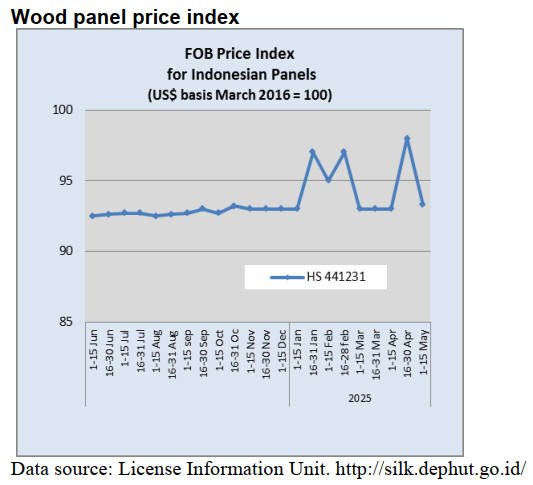
5.
MYANMAR
Bago Yoma forests threatened
A frontier-myanmar article has a story captioned “The fate
of Bago Yoma is threatened by the armed conflict” in
which it is written “illegal logging in the Bago Yoma
mountain range seemed to have surged since 2021”.
In May 2016 the National League for Democracy
government imposed a one-year moratorium on logging
throughout Myanmar. The suspension was extended to 10
years to 2026 in the Bago Yoma because the range was
particularly hard hit by deforestation.
The article claims “armed groups on both sides of the
conflict are reportedly involved, either through direct
logging, toll gate collection or permitting operations”.
See: https://www.frontiermyanmar.net/en/logged-out-conflict-
drives-deforestation-in-bago-mountains/
Foreign Investment declined
It has been reported that foreign investment in Myanmar,
which has been declining year by year since 2021 totalled
only US$690 million in the 2024-25 fiscal year that ended
on 31 March. Of the 12 investment sectors, only seven
received investment, including agriculture, livestock,
manufacturing, energy, oil and gas, transportation and
services.
The oil and gas sector received the most followed by
manufacturing, transportation and communications and
services.
Of the 14 countries that invested in Myanmar, Singapore
invested the most with US$460 million followed by China
(US$94 million), Thailand (US$46 million) and Hong
Kong ( US$30 million).
See: https://burmese.dvb.no/post/702938
Post-earthquake economic reality
The magnitude 7.7 earthquake that struck central
Myanmar on 28 March left a trail of destruction across
Mandalay, Sagaing, and Naypyidaw.
The disaster has crippled Myanmar’s economy,
devastating Mandalay’s industrial zones and supply
chains. Damaged infrastructure, including roads, bridges
and a key Sagaing-Mandalay bridge, has restricted access
to Mandalay’s river port disrupting agricultural logistics.
The earthquake’s fallout is forecast to exacerbate poverty,
inflation and result in a decline in exports.
The SAC’s reliance on a multiple exchange rate system
risks further economic distortion, while strict import
licensing hampers recovery efforts. Domestic insurers, hit
by sanctions and limited reinsurance, face challenges,
leaving reconstruction costs largely on citizens due to low
insurance coverage.
See - https://www.scmp.com/week-
asia/opinion/article/3309792/how-myanmars-devastating-
earthquake-threatens-leave-lasting-economic-scar
6.
INDIA
Sawnwood and veneer
prices edge up
The annual rate of inflation based on the all India
Wholesale Price Index (WPI) was 2.05 in March. The
positive rate of inflation in March was primarily due to
increase in prices of manufactured food products, other
manufacturing, food articles, electricity and manufacture
of textiles.
The index for manufacturing rose to 144.4 in March from
143.8 in February. Out of the 22 NIC two-digit groups for
manufactured products, 16 groups saw an increase in
prices, 5 groups a decrease and 1 group no change.
Some of the important groups that showed month on
month increases in price were manufacture of basic
metals, food products, other transport equipment, other
manufacturing and machinery and equipment. The indices
for sawnwood and veneers rose in March from a month
earlier.
Some of the groups that saw a decrease in prices were
manufacture of textiles, chemicals and chemical products,
computers, electronic and optical products; printing and
reproduction of recorded media and furniture.
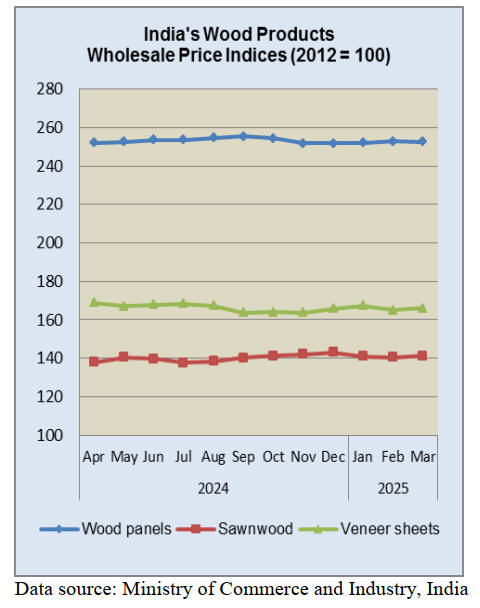
India/ New Zealand FTA negotiations
The New Zealand Trade Minister, Todd McClay, has
reported a government delegation visited India to begin
free trade negotiations. The Minister said “following
significant engagement over the past month, the first in-
person round of negotiations towards a comprehensive
India-New Zealand free trade agreement will take place”.
The New Zealand Timber Industry Federation (NZTIF)
has signaled its support for the proposed NZ-India Free
Trade Agreement saying “the Federation is excited by the
possibilities that exist for New Zealand Radiata sawnwood
in India”.
The NZTIF has identified that, at present, sawnwood
exports to India from New Zealand are negligible, totalling
just NZ$10 mil. over the last 5 years. Sawn softwood
imports into India from other countries shows a different
picture.
The NZTIF notes India is one of the largest importers of
timber globally with a significant demand for various
types of wood products and imports from various
countries including Malaysia, Germany as well as from
teak producing countries. The woodworking industry in
India is one of the fastest-growing sectors, with a growing
demand for wood and wood products.
In a statement the NZFIF says “we consider it important
that, to best capture the maximum value from NZ, a real
emphasis needs to be placed on the qualities of NZ
Radiata including it’s treatability, ease of working and
importantly sustainability of NZ resource. It is vital that
Radiata is marketed as a timber that “covers all bases”
from high end finishing to construction and packaging.
See: https://www.nztif.co.nz/news/nztif-strongly-supports-
nz-india-free-trade-agreement
Kerala – particleboard production hub
Kerala has emerged a particleboard manufacturing hub in
India according to an article in the March PlyReporter
magazine. In the last quarter of the 2025 financial year
four new manufacturing lines commenced commercial
production adding approx. 1,000 cubic metres per day to
capacity in the State.
Two new particle boards lines have been commissioned in
Kannur district of Kerala. Particleboard from Kerala
serves the entire southern India market.

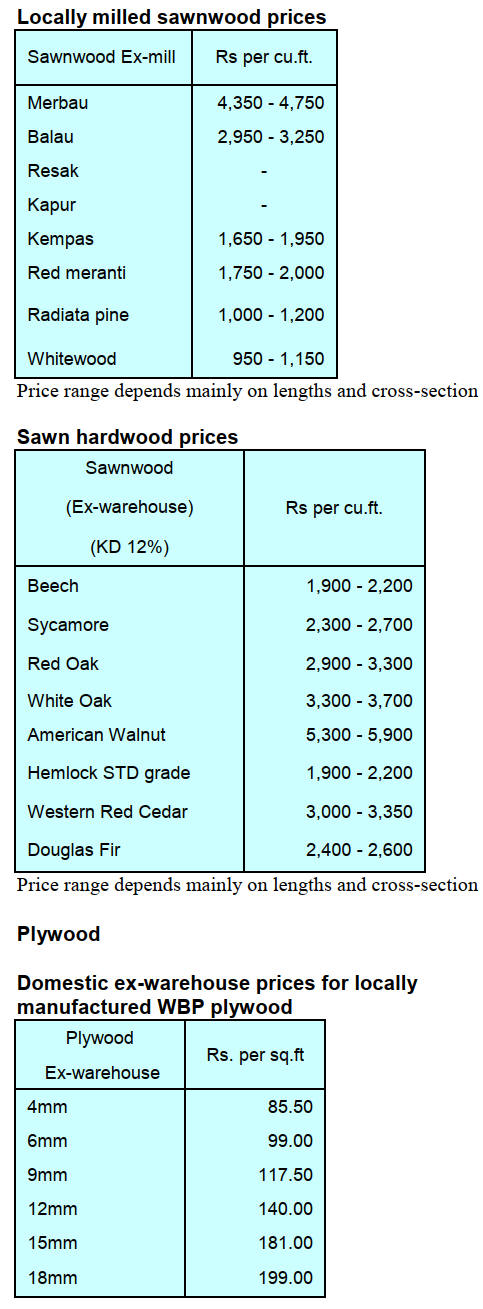
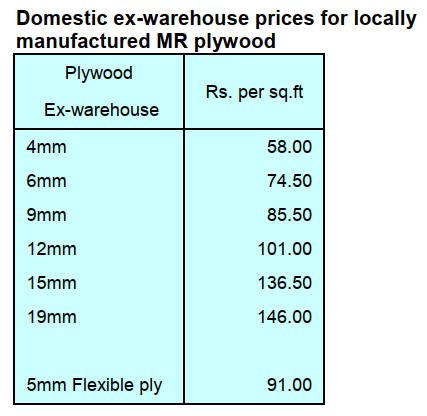
7.
VIETNAM
Wood and Wood Product (W&WP) trade
highlights
According to statistics provided by Vietnam Office of
Customs the W&WP exports in April 2025 reached
US$1.4 billion, an increase of 3% compared to April 2024.
Of which WP exports contributed US$964 million, up
2.7% compared to April 2024.
In the first four months of 2025 W&WP exports totalled
US$5.3 billion, an increase of 9% over the same period in
2024. Of which WP exports alone, fetched US$3.6 billion,
up 9% compared to the same period in 2024.
Viet Nam’s W&WP exports to the EU in April 2025 were
valued US$54 million, up 23% compared to April 2024. In
the first four months of 2025 exports to the EU have been
estimated at US$215 million, an increase of 4% compared
to the same period in 2024.
Raw wood (logs and sawnwood) imports in April 2025
reached 631,000 cu.m valued at US$195.6 million, an
increase of 8% in volume and 10% in value compared to
March 2025 and up 39% in volume and 28% in value
compared to April 2024.
In the first four months of 2025 raw wood imports stood at
2.09 million cu.m, valued at US$647.3 million, up 38% in
volume and 29% in value compared to the same period in
2024.
Vietnam’s export of handicraft products in March 2025
amounted to US$94.40 million, an increase of 36%
compared to February 2025 and up 4.5% compared to the
same period in 2024. In the first three months of 2025
export of handicrafts reached US$260.10 million, an
increase of 2.5% compared to the same period in 2024.
Vietnam’s NTFP exports in March 2025 reached
US$78.44 million, an increase of 39% compared to
February 2025 and up 6% compared to the same period in
2024. In the first three months of 2025, exports of these
products contributed US$209.18 million, up 4% compared
to the same period in 2024.
Promoting transparency and restructuring production
in the timber industry
In the context of possible imposition of reciprocal tariffs
by the US businesses are gently trying to assess the impact
on exports to the US. Promoting the application of
technology to optimise production processes, control
quality, trace the origin of raw materials and manage input
factors are emerging as key solutions for enterprises in the
wood industry.
According to the Ministry of Agriculture and Environment
the US remains the largest consumer of Vietnamese wood
and wood products representing 53% of total exports.
Binh Dinh Province is home to more than 300 wood-
processing enterprises with major export products
consisting of indoor and outdoor furniture, wood pellets
and woodchips. In 2024, wood exports to the US brought
in US$604 million and accounted for 35% of the
Province’s total trade. Following the news of potential
reciprocal duties some US customers have asked to
renegotiate existing orders and temporarily suspended the
signing of new contracts.
Similarly, Bac Kan Province has 22 export enterprises.
Two of these export directly to the US which accounts for
55% of their total output.
A report assessing the impact on Bac Kan’s export
businesses to the US indicates that if a 46% reciprocal
duty were applied it would have a direct effect not only on
those companies exporting to the US but also on
businesses involved in the export supply chain.
The industrial growth rate in Bac Kan is forecast to fall by
around 1–2% in 2025 with wood export revenue declining
by US$8–10 million. Some companies may be forced to
reduce their workforce which could affect local social
welfare.
According to Dinh Lam Sang, Deputy Director of the Bac
Kan Department of Industry and Trade, the 90-day
suspension of tariff imposition by the US provides
opportunities for businesses to have more time to adjust
their operations and prepare response measures. It is also a
valuable opportunity to lay the groundwork for negotiating
long-term trade agreements and for seeking to diversify
export markets.
However, some businesses have expressed concern over
the difficulty of market redirection. Each export product
line is backed by its own production system and shifting to
new markets involves more than just trade promotion or
finding new orders. It also requires significant financial
investment in production lines.
Tran Quoc Bao, from Thien Loc Import-Export Company
remarked that, while switching markets is a sound
strategy, it is not easily executed. The US currently
accounts for nearly 70% of Viet Nam’s total wood export
value. Only about 10% of businesses are capable of
shifting to alternative markets.
“A 10% tax rate is bearable if both sides share the risk
equally but any higher rate could force factories to shut
down. We may have to consider switching production to
serve domestic consumption in order to maintain stable
livelihoods for over 100 workers,” Bao explained.
Several localities are currently implementing plans to
work with export companies on solutions to boost trade
promotion and expand market access to the EU, Japan, the
Republic of Korea and Southeast Asia. At the same time
they are helping businesses access capital to maintain
production and expand domestic sales.
Many have proposed that the Government adopt both
immediate and long-term comprehensive measures to
support businesses with legal procedures, trade defense
investigation dossiers in English (as required by the US)
and strengthen support for provincial enterprises in
promoting exports to alternative markets.
Ngo Sy Hoai, Vice Chairman and Secretary-General of the
Viet Nam Timber and Forest Products Association, noted
that Vietnamese exports to Japan have traditionally
consisted of wood chips and some types of panel products.
Given the current pressure from the US Vietnamese wood
enterprises should now explore the potential to export
indoor furniture suitable to Japanese consumer
preferences. As for China, with its population of 1.4
billion, Viet Nam’s exports have mostly focused on wood
chips for paper production. However, if we work hard we
could still find outlets for certain products, said Hoai. The
Republic of Korea offers logistical advantages with a
relatively short sea transport distance and strong trade
relations. Yet, Vietnamese companies have so far mostly
supplied low-cost wood pellets and plywood to this
market.
Even the EU, with 27 member states and covered by the
EVFTA, wood products export accounts for only 3–4% of
Viet Nam’s total wood exports.
Some other markets, such as Russia, the Middle East and
countries within ASEAN also need to be studied, opened
up and activated. These markets still hold untapped
potential that Vietnamese wood exporters must seize to
compensate for the substantial gap that may arise from US
tariff policies.
In addition, wood and forest product exporters must
prepare full legal documentation to prove the legal origin
of their timber materials. It is essential to maintain
transparency in the production process and raw material
sourcing. At the same time, businesses should research to
change the structure of raw materials sources and
production structure and make a shift to domestic
plantation wood materials to minimise dependence on raw
materials and semi-finished products from outside the
country.
See: https://en.nhandan.vn/promoting-transparency-and-
restructuring-production-in-wood-industry-post147806.html
Forestry sector to revise regulations to address
challenges and streamline governance
Land allocation policies have brought about positive
changes in forest protection and forestry development and
have helped to mobilise social resources, especially local
communities, to join state forestry companies in
management efforts.
However, policy implementation has also exposed
significant gaps and limitations, particularly in land and
forest management.
The forestry sector in Vietnam is looking to develop a
decree aimed at amending current regulations and
resolving issues, particularly those related to governance
at both the central and local levels, while addressing
difficulties in the field.
According to the Ministry of Agriculture and
Environment, after 30 years of implementing land
allocation policies, forestry companies across the country
have placed nearly 460,000ha, equivalent to about 27% of
the total area, under management.
Deputy Minister of Agriculture and Environment Nguyễn
Quốc Trị said that of the nearly 460,000ha allocated by
forestry companies, 68% was allocated under Decree
01/CP, which pertains to land allocation for agricultural,
forestry and aquaculture production by State-owned
enterprises.
Additionally, 29% of the land was allocated under Decree
135/2005/NĐ-CP.
Just 3% of the allocated land was governed by Decree
168/2016/NĐ-CP, which regulates land allocation for
forests, orchards and water surface areas within the
authority of special-use forest management boards,
protective forests and one-member limited liability
forestry companies owned by the State.
The Ministry’s representative said that land
allocation has
brought about positive changes in forest protection and
forestry development.
However, the policies' implementation has exposed some
problems.
This led to a decision by the Politburo in December 2024
to issue Conclusion 103-KL/TW, which directs further
improvements to institutional frameworks, especially legal
documents concerning land use, public asset management
and the swift restructuring and modernisation of
agricultural and forestry companies.
A report by the Vietnam Association for Agricultural
Economics and Rural Development titled 'The study and
evaluation of the current status and proposed solutions for
allocating forest land in forestry companies' also stated
that, while land allocation has played a crucial role in
greening barren lands, the implementation process has
revealed several issues.
The Vice President of the Association, Nguyễn Văn Tiến,
said that under Decree 135/2005/NĐ-CP, households are
allowed to build homes for forest supervision and
temporary shelters for storing equipment.
However, the management of allocated areas by forest
management units has been lax, leading to unauthorised
land use changes and construction of buildings.
Moreover, there is no legal framework specifying how to
handle violations by communities, groups or households
engaged in forest protection activities when such
infractions occur on allocated land.
The lack of clear guidelines for managing assets on the
land such as crops, homes and temporary structures when
contracts are terminated or land is reclaimed also remains
a significant issue.
Proposals for improvement
In light of these challenges the Association has called for
the Government to revise the policy on forest and forestry
land allocation. It recommends revisions should allow
companies that have received land leases to independently
implement business measures in accordance with legal
provisions.
The relevant authorities could also strengthen inspection,
monitoring and guidance on land use management, the
issuance of land use certificates and the development of
management plans for forestry companies’ land, especially
when the land is returned to local communities. Such plans
should address the land needs of minorities, ensuring
social security and welfare.
Hà Công Tuấn, former Deputy Minister of Agriculture and
Rural Development, stressed the importance of shifting the
focus of forest allocation policies from social welfare to
economic development ensuring the protection of forest
workers' rights and improving the management of forest
resources.
Director of the Forestry and Forest Protection Department,
Trần Quang Bảo, said that this year the forestry sector will
focus on researching and drafting an inclusive decree that
revises existing laws to address the challenges within the
sector.
The proposals are expected to contribute to refining the
policy framework, improving land management and
enhancing the sustainable development of Việt Nam's
forestry sector in the near future.
See: https://vietnamnews.vn/environment/1716999/forestry-
sector-to-revise-regulations-to-address-challenges-and-
streamline-governance.html
8. BRAZIL
Low efficiency of regional timber sector
highlighted
During the 4th Amazon Seminar the National Institute for
Amazonian Research (INPA) presented the results of the
National Institutes of Science and Technology (INCT)
Amazon Timber Project focusing on applied innovations
and institutional partnerships aimed at addressing the
challenges faced by the region's timber industry.
The project highlighted the low efficiency of the regional
timber sector which utilises less than 30% of the log
volume, resulting in losses exceeding 60%. It was reported
that the Forest Management Laboratory (LMF) has been
developing and applying technologies such as remote
sensing, drone and algorithms for mapping, monitoring
and optimising logging and processing.
The LMF has also been working on sustainable
alternatives for the use of forest residues with applications
in civil construction and the furniture industry. One
notable development is the production of interactive
panels structured with cross-laminated doweled wood
(PLCC), similar in concept to cross-laminated timber
(CLT), using lesser-known Amazonian timber species.
At the ecosystem level INPA highlighted the development
of statistical models for estimating biomass and carbon
stocks with a 5% margin of error based on the felling and
weighing of more than 500 trees. Forest inventories are
being conducted for continuous monitoring of carbon
sequestration.
These ecosystem service-related studies aim to align with
sustainable forest management to add greater value to
timber and support global climate modeling. The
integration of science, technology and education reaffirms
the institution’s commitment to the sustainability of the
Amazon.
See:
https://www.yumpu.com/pt/document/read/70417637/florestal-
273web
Unblocking approval processes for forest management
plans
The Center for Timber Producing and Exporting Industries
of Mato Grosso State (CIPEM) and the Brazilian Institute
for Environment and Renewable Natural Resources
(IBAMA) held a meeting in Cuiabá to discuss ways to
improve the approval processes for Sustainable Forest
Management Plans (SFMP) involving CITES-listed
species such as Ipê (Handroanthus spp.), Cumaru
(Dipteryx spp.) and Cedro (Cedrela odorata).
According to the National Forum on Forest-Based
Activities (FNBF) Normative Instructions (IN) No.
28/2024 and No. 5/2025 established criteria considered
overly strict halting forest management operations and
raising concerns within the export sector.
One of the key issues addressed was the challenge posed
by the application of these Normative Instructions which
introduced demanding requirements for the management
of CITES-regulated species.
The FNBF considered the initial demands unfeasible
which has led to the paralysis of several management
processes. In response, CIPEM, FNBF and other industry
associations have been negotiating adjustments with
IBAMA.
The expectation is that reviewed pocesses will be released
following alignment between the State environmental
agency (SEMA) and IBAMA thus avoiding negative
social and economic impacts.
The meeting also emphasised the need to standardise
technical criteria between Federal (IBAMA) and State
environmental agencies (SEMA-MT) including alignment
on the application of concepts such as Annual Production
Unit (UPA), Work Unit (UT) and parameters like Rarity
Index and the Volumetric Yield Coefficient (CRV).
IBAMA reaffirmed that evaluations should be based on
the UPA and Annual Operating Plan (POA), with Work
Units serving only as technical calculation reference.
Additionally, there was concern about Normative
Instruction No. 19/2024, which makes the approval of
SFMP conditional on full validation of the Rural
Environmental Registry (CAR). This could jeopardise
forest operations even in States that have made significant
progress in CAR analysis, such as Mato Grosso.
Another issue reported was the inconsistency between the
Federal (SINAFLOR) system and State systems resulting
in the denial of export licenses at ports due to missing
authorisations (Autex/Rautex) within SINAFLOR. CIPEM
formally requested that IBAMA refrain from rejecting
processes outright and instead issue pending status
notifications while awaiting system corrections.
CIPEM and FNBF continue to monitor the negotiations
closely and emphasise the importance of effective
institutional coordination to ensure legal certainty,
expedite administrative procedures, maintain sustainable
forest production, preserve jobs and uphold socio-
environmental commitments in Mato Grosso.
Further technical meetings between SEMA and IBAMA
are scheduled to address both regulatory and operational
adjustments.
See: https://noticiaexata.com.br/geral/cipem-e-ibama-buscam-
destravar-processos-de-manejo-florestal-em-mato-grosso/
Wood panel exports increased in 2024
The Brazilian planted forest sector showed a strong export
performance in 2024 according to the Brazilian Tree
Industry (Ibá) with a record trade surplus of US$15.7
billion, representing growth of 23.5% compared to 2023.
According to Ibá, in 2024 the main products that recorded
increased exports were wood-based panels, up by 37%
(US$409 million), followed by plywood (+23%; US$793
million) and paper (+5%; US$2.5 billion). Pulp, the
sector's main export product, ended 2024 with a 33%
increase (US$10.6 billion).
In terms of production Brazil achieved record figures in
2024 reaching 25.5 million tonnes of pulp (a 5.2%
increase) and 11.3 million tonness of paper (+4.6%).
Wood panel exports totalled 1.4 million cu.m marking a
significant growth of 39%, while domestic demand rose to
8.3 million cu.m an increase of 16%.
The forest sector accounted for 4.7% of Brazil’s total
exports (up 1% compared to 2023) and represented 9.5%
of the country's agribusiness exports (up 1.9% from 2023).
Key international markets also showed strong
performance: China imported US$4.8 billion (+21%),
Europe US$3.6 billion (+45%) and North America US$3.5
billion (+24%).
In 2024, China increased its imports of the three leading
export products from Brazil compared to the previous
year: pulp (+21%), paper (+63%) and wood panels
(+94%). In North America, overall imports increased by
approximately 24%, with wood panels standing out with a
57% rise. However, the bulk of the trade value came from
pulp shipments, which totaled US$1.7 billion, a 40%
increase over 2023.
See: https://emobile.com.br/site/industria/vendas-externas-de-
paineis-alcancam-us-409-milhoes/
Amazon Network for Integrated Fire Management
In April the 2nd Regional Meeting of the Amazon
Network for Integrated Fire Management (RAMIF) was
held in Quito, Ecuador. The initiative, led by the Amazon
Cooperation Treaty Organization (ACTO), aims to
advance the harmonisation of regional strategies for the
prevention, monitoring and suppression of wildfires while
strengthening technical and institutional cooperation
among Amazonian countries.
Brazil was represented by the Brazilian Institute for
Environment and Renewable Natural Resources (IBAMA)
through its National Center for the Prevention and
Suppression of Forest Fires (Prevfogo) which shared
Brazil’s experience in forest fire prevention, monitoring
and firefighting.
During the event, the eight member countries (Bolivia,
Brazil, Colombia, Ecuador, Guyana, Peru, Suriname and
Venezuela) presented an overview of their recent actions
related to Integrated Fire Management (IFM), exchanged
best practices and identified concrete opportunities for
collaboration.
The meeting’s key outcome was the development of a
shared operational understanding among Amazonian
nations aimed at harmonising emergency response
protocols for forest fires and enhancing technical and
institutional exchanges.
At the national level, RAMIF is coordinated by the
Brazilian Cooperation Agency (ABC) with the
involvement of the Ministry of the Environment and
Climate Change (MMA), the Chico Mendes Institute for
Biodiversity Conservation (ICMBio) and IBAMA
demonstrating Brazil’s interinstitutional and integrated
approach to environmental policy and its commitment to
sustainable solutions for the Amazon.
See: https://www.gov.br/ibama/pt-
br/assuntos/noticias/2025/brasil-reforca-alianca-amazonica-em-
defesa-das-florestas
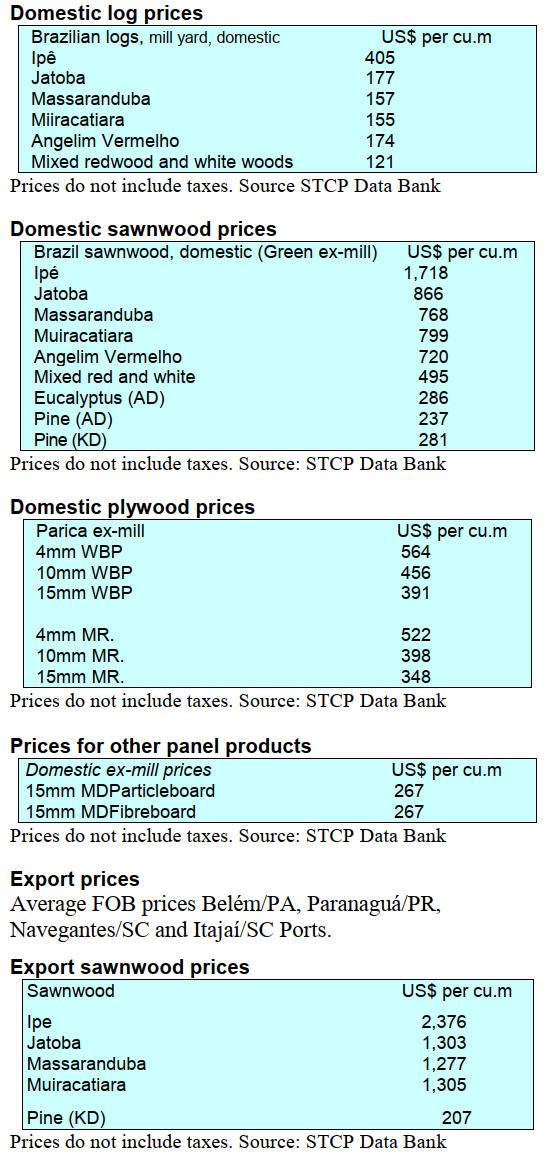
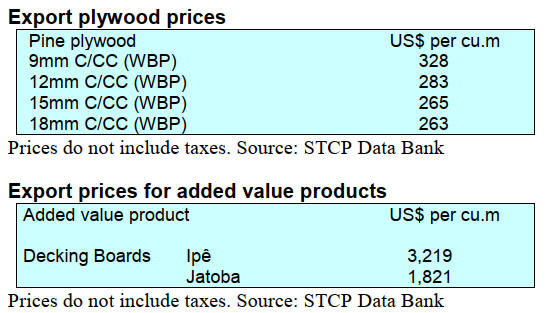
9. PERU
Forest Certification
Peru - new board members
appointed
During an Extraordinary General Assembly of Associates
of Forest Certification Peru (CFPeru) three new board
members were appointed for the period 2025-2027. Those
elected were Yolanda Ramírez, Miriam Matorela and
María Trujillo.
CFPeru reaffirmed its commitment to promoting
responsible forest management that guarantees
environmental sustainability, social well-being and
economic viability.
FSC Peru strengthens capacity on the new forest
management standard in Ucayali
FSC Peru held a workshop "Updating and Capacity
Building on the New Forest Management Standard for
Peru". This was held at the facilities of CITE Forestal
Pucallpa in collaboration with the CITE Forestal Pucallpa.
The event brought together 22 representatives of certified
forestry companies and others potentially interested in
adopting this certification as well as regional authorities
such as OSINFOR and the Ucayali Forestry Department.
The training developed the ten principles of the FSC
standard, highlighting crucial topics such as legal
compliance, labor rights, indigenous rights, community
relations, forest benefits, environmental impacts,
management planning, monitoring, conservation of high-
value forests and forest management activities.
New technologies to identify species
As part of its commitment to more accurate and evidence-
based monitoring, OSINFOR trained fifteen specialists in
the use of new technologies to identify wood species.
Thanks to the collaboration with CITEmadera y del
Mueble, a decentralised body of the Instituto Tecnológico
de la Producción (ITP), the technical team strengthened
skills in the use of the Xylotron system, the DART-
TOFMS methodology and the visual recognition of
species through their anatomy.
The training sessions for OSINFOR technical staff focused
on the advantages, scope and limitations of the Xylotron, a
computer vision tool that compares microscopic images of
wood with a database to determine the species and the
DART-TOFMS, a mass spectrometer that chemically
analyses a small sample and provides accurate results,
even for processed wood.
These tools are especially relevant in contexts where
traditional methods do not provide sufficient elements to
confirm the identity of the forest resource. In the
monitoring processes carried out by OSINFOR the results
obtained with these technologies can be used as scientific
evidence to address forest law violations.
As part of the training practical sessions were also held to
recognise ten Peruvian wood species through their visible
anatomical characteristics, a fundamental skill in the field
when specialized equipment is unavailable.
See: https://www.gob.pe/institucion/osinfor/noticias/1164433-
nuevas-tecnologias-respaldan-labor-del-osinfor-para-verificar-la-
legalidad-de-la-madera
Assessing rate of illegal logging
In a joint effort, the Regional Forest and Wildlife
Development Management (GERFOR) and the Forest and
Wildlife Resources Oversight Agency (OSINFOR) have
begun assessing the rate of illegal logging that occurred in
2024. This important input aims to generate information to
understand the dynamics of timber supply and demand
from the forest to the initial processing, strengthen its
traceability, identify areas and modalities of access to
forest resources at greatest risk and thus provide evidence
to improve decision-making in forest management in the
region.
The OSINFOR and GERFOR technical teams will
continue implementing the work plan to deploy field
measurements based on the data and records obtained
during 2024. This process will be key to strengthening the
regional government's capacities and in moving toward
more transparent, efficient and coordinated forest
management.
See: https://www.gob.pe/institucion/osinfor/noticias/1161977-
loreto-inicia-primera-medicion-del-indice-y-porcentaje-de-tala-y-
comercio-ilegal-de-madera-como-medida-para-fortalecer-la-
gestion-forestal
An intercultural tool to prevent forest fires
As part of the Second Regional Meeting of the Amazon
Network for Integrated Fire Management (RAMIF),
organised by the Amazon Cooperation Treaty
Organization (ACTO), the Forest and Wildlife Resources
Oversight Agency (OSINFOR) of Peru presented the
Forest Backpack for Forest Fire Prevention, an educational
and intercultural tool that promotes integrated and
sustainable forest management.
During his presentation, OSINFOR's Director of Forest
and Wildlife Capacity Assessment and Development
explained that the Forest Backpack seeks to strengthen the
capacities of indigenous, peasant and rural communities
through a participatory, visual and fun methodology
adapted to diverse cultural contexts.
The tool was recognised as a replicable best practice by
delegations from several Amazonian countries.
See: https://www.gob.pe/institucion/osinfor/noticias/1158815-
osinfor-presenta-herramienta-intercultural-para-prevenir-
incendios-forestales-ante-ocho-paises-de-la-red-amazonica
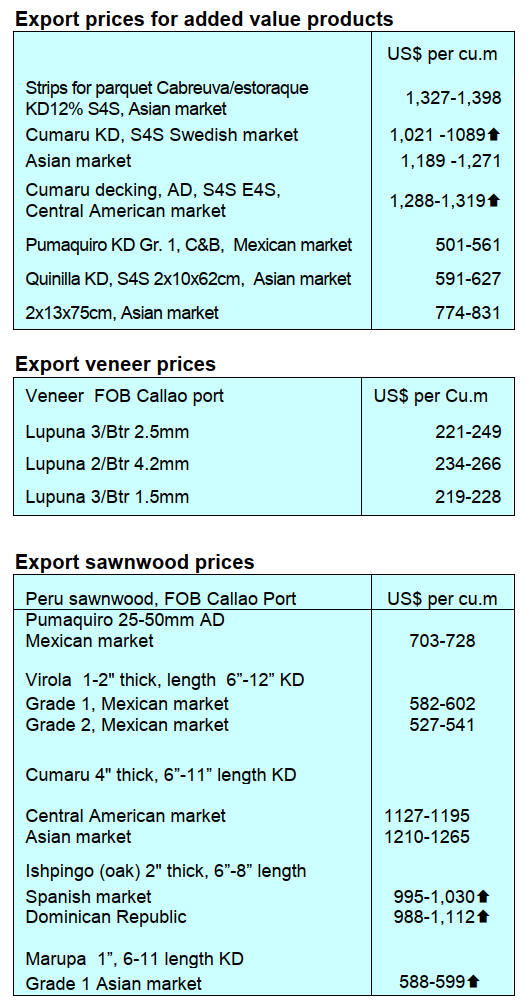

|